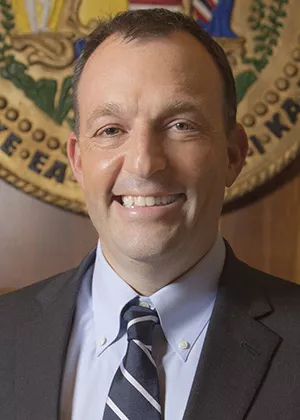Lieutenant Governor Josh Green '92 Helps Hawaii Contain Coronavirus

POLITICO: How Hawaii Became a Rare Covid Success Story
In mid-February, Hawaii did not yet have any recorded cases of Covid-19, and only 15 infections had been confirmed throughout the United States. But Josh Green '92, the lieutenant governor and a practicing emergency room doctor, was worried.
He recently had learned that a man from Japan had spent nine days in the state and then tested positive for the virus upon returning home to Nagoya. The man, apparently, was sick—and contagious—toward the end of his vacation. He and his wife, who would later test positive herself, stayed in two hotels, one on Maui and one in Waikiki. They got in rental cars, went shopping in Chinatown, ate out at more than half a dozen restaurants, and met a friend in Honolulu for coffee.
How many people had the couple unwittingly infected in that time, Green wondered? “For me, it really underscored the need to get ready. Because this thing is so contagious, it could get out of control very fast,” he says.
His fears weren’t unfounded. With 28,000 travelers pouring into Hawaii every day during the months of January and February, 20 percent of them from Asia, the state seemed fertile ground for a major Covid-19 outbreak. That was especially true on Oahu, where at least one-third of the state’s visitors cram into the hotels, stores, restaurants and beaches that line Waikiki’s 2 miles. Even without tourists, Oahu, where the bulk of the state’s population lives, is jam-packed—significantly more so than New Jersey, the nation’s most densely populated state.
But a catastrophe never came. Instead of a massive, uncontrolled outbreak, Hawaii has recorded the fewest Covid-19 cases per capita in the country. As of this writing, just one person per 100,000 has died (17 in total), and 54 per 100,000 have tested positive (762 in total). By comparison, New Hampshire and Rhode Island, two states with similar population counts, have caseloads of 406 and 1,546 per 100,000, respectively. For six weeks in April and May, new cases in Hawaii didn’t top five a day. At the beaches, where mask-free residents gather largely without tourists, you can almost start to forget about a virus that has upended lives across the globe.
---
In the weeks before the arrival quarantine went into effect in late March, many expected the virus to have spread far more widely through the population than it did.
That it didn’t, and that Hawaii has continued to keep cases low, is a function not of the usual dynamics—the top-down operation helmed by a high-profile leader, as in states like New York and Michigan or countries like New Zealand and China. Hawaii’s success came at the hands of several medical doctors: Green, the outspoken lieutenant governor, along with an enterprising private physician, both of whom pushed for aggressive testing while clashing with the state’s top epidemiologist, who ran a tireless contact tracing program that has managed to track all of the state’s confirmed cases to date. In the background was a low-key governor who listened to the voices around him and made quick decisions when he needed to.
With arguments still flaring up across the country about the most effective way to manage the coronavirus response—often divided between those who want a heavy government hand and those who don’t—Hawaii’s experience shows that sometimes what works best is a multipronged, even redundant approach.
---
When higher caseloads inevitably appear, Green says he thinks the state will be ready to respond without the extreme shutdowns that were necessary in March. The department of health, for instance, now has on call an additional 160 volunteer contact tracers for when the need arises. “We’ve beefed up our contact tracing and testing capacity by orders of magnitude,” he says. “And a lot of our understanding about the virus has matured. We’re stronger, and we can definitely manage it.”



